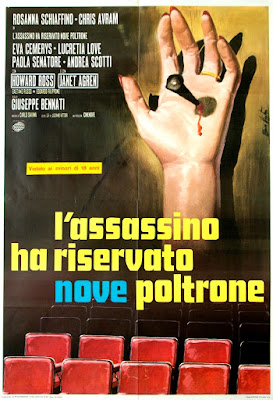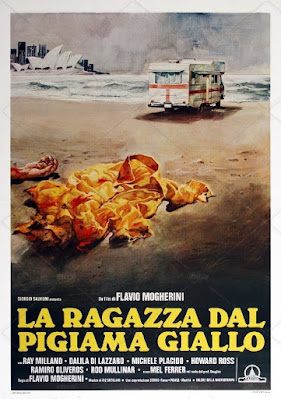
Good Manners (As
Boas Maneiras) (2017) In this surprising
film by Brazilian writer/director team Juliana Rojas and Marco Dutra, Ana (Marjorie
Estiano), a young well-to-do pregnant woman hires Clara (Isabél Zuaa) as a
personal assistant/nanny. Clara soon finds that her employer has some unusual nocturnal
habits, which provide some clues about her unborn child. Good Manners holds its
cards close to its chest, taking time to establish the main characters before
delving into the more fantastical elements of the second half. The filmmakers
employ a blend of visual styles and tones (including some brief musical
interludes), weaving its tale of unselfish love and personal sacrifice. As in
many werewolf movies (the creature is brought to life through a skillful combination
of animatronics and CGI), there’s a tragic, fatalistic streak that runs throughout,
about the immutability of changing one’s nature. It’s better not to know too
much about this film going in, instead allowing the melancholy story to unfold.
Rating: ****.
Available on DVD and Kanopy

Gonjiam: Haunted
Asylum (2018) “Horror Times,” a YouTube-style channel exploring the most
haunted places on earth, sets its sights on an abandoned mental hospital (where
multiple unexplained deaths occurred), considered one of the most haunted
places on Earth. In an effort to get 1 million viewers, the host/show director Ha-Joon
(Ha-Joon Wi) stacks the deck by staging some paranormal occurrences. He didn’t consider,
however, that the restless spirits in the place would create their own
disturbances for his team of investigators. Soon, Ha-Joon and the other team
members are in a desperate struggle for their sanity and their lives. Director/co-writer
Beom-sik Jeong’s found footage horror movie starts out light in tone, getting progressively
tense as it approaches a grim conclusion. While, the individual components of
the film are nothing new, it’s an intense experience that provides some genuine
scares. See it before the inevitable American remake.
Rating: ***½. Available on Blu-ray, DVD and Amazon Prime
Popcorn (1991) This playful, affectionate ode to
B-horror flicks and William Castle-esque gimmicks prefigures Joe Dante’s Matinee (1994) by a few years. Ray
Walston appears (in a cameo role) as Dr. Mnesyne, movie memorabilia collector extraordinaire.
He provides vintage props for a group of college film students staging a movie marathon
fundraiser. Unfortunately for the students, a homicidal maniac has other plans,
as he lurks about the old movie house, picking off people one by one. As we
soon discover, the killer has a vested interest in Maggie (Jill Schoelen), one
of the student organizers. Popcorn never takes itself too seriously, seemingly
anticipating the many self-referential horror films that followed in its wake. Some
of the most enjoyable elements in the film are the “let’s put on a show” aesthetic,
as well as the clever ‘50s-style parodies within the movie (which would make
great features by themselves).
Rating: ***½. Available
on Blu-ray and DVD
Veerana (1988) This energetic film from purveyors of
Bollywood horror, Shyam and Tulsi Ramsay, pushed the boundaries of what Indian censors
would allow (it would probably be a PG in the States). After the succubus
Nakita (Roy Kamal) is destroyed, an evil sorcerer (Rajesh Vivek) attempts to
resurrect her spirit, placing a curse on a local family. He plans to bring her
back through the family’s daughter Jasmine (Jasmin). The possessed young woman
follows in Nakita’s footsteps, luring naïve men to their doom. Of course, there’s
plenty of time for song and dance numbers, which have little to do with the
plot, and pad out the running time. But fear not, dear reader; you never have
to wait too long before something else occurs. There’s more going on in the
opening credits sequence than most other movies. Veerana has something for
everyone, with action, drama, suspense, romance, horror, gore, music and (bad)
comedy.
Rating: ***½.
Available on DVD (included in The Bollywood Horror Collection, Volume 2)
Hex (aka: Xie) (1980) In this demonic
horror, Shaw Brothers style, a loutish, alcoholic man conspires with his
mistress (posing as a servant) to scare his ailing wife to death. All goes as planned,
until his deceased wife returns to punish the two lovers. Director/co-writer Chih-Hung
Kuei’s film has several jarring tonal shifts, in which the drama with the
abusive husband suddenly lapses into comedy. Also, if some of the musical cues
sound suspiciously familiar, your ears aren’t deceiving you (some snippets of
the soundtrack appear to have been lifted from Alien and Star Trek: The Motion Picture). It’s difficult to have sympathy for the
unscrupulous couple’s dilemma, but it sets up the film’s most memorable final
sequence, when a Taoist shaman attempts to exorcise the spell. Filled with style
and detailed sets, it’s well worth a look, if you can find a copy.
Rating: ***. Available
on Blu-ray (Region B) and DVD (Region 2/3)

The Living Corpse (aka: Zinda Laash) (1967) Here’s a rarity,
a Pakistani retelling of Dracula, thought lost for decades. Luckily for us, it’s
been restored for future generations to enjoy. A mad scientist (Rehan) develops
an elixir of life and tests it on himself. From that point onward, the movie more
or less follows Bram Stoker’s story (albeit in a modern-day setting), as he becomes
a bloodthirsty vampire. The filmmakers were obviously taking notes from Hammer’s
version, rather than the Universal film, with Rehan’s more visceral take on the
vampire. When he makes his entrance, walking down a staircase, it’s easy to
imagine Christopher Lee following the same steps. On the other hand, The Living Corpse has some touches Stoker and Hammer never thought of, including several
jaunty song and dance numbers (Also, the opening credits sequence inexplicably
uses “La Cucaracha.”). In this version, the antagonist doesn’t transform into a
bat. Instead of a ghostly carriage, he traverses point A to point B in a car. If
you can accept the creaky set design and sillier aspects, it’s a fun repurposing
of Stoker’s enduring character, worthy of re-discovery.
Rating: ***.
Available on DVD
Even the Wind is
Afraid (aka: Hasta el Viento Tiene Miedo) (1968) In this gothic Mexican supernatural
mystery from writer/director Carlos Enrique Taboada, Claudia (Alicia Bonet), a
girl at an exclusive prep school is haunted by the ghost of a former student
who died under mysterious circumstances. Much to her dismay, she has a tough
time convincing her fellow classmates (all of whom are portrayed by actresses
in their 20s) or the stern headmistress (Marga López). Only the elderly groundskeeper
Diego (Rafael Llamas, with fake gray hair) seems to believe her. It’s rather slow-paced
but there are some tense scenes
throughout, and an impromptu strip-tease livens things up. Although it’s short
on action, it’s a great looking, atmospheric thriller, worth checking out.
Rating: ***. Available
on Blu-ray, DVD and Tubi
Frankenstein 1970 (1958) A film crew prepares to shoot a horror
movie in the real-life Frankenstein’s castle, home of the last living heir of the
infamous scientist (Boris Karloff). We soon discover that the not so good
doctor has ulterior motives, as the filmmakers disappear one by one. Despite the
meta-possibilities of the premise, the majority of the movie is slow and
plodding, much like the titular creature. An inordinate amount of time is wasted
on a pointless subplot about the director’s ex-wife/screenwriter and a new
starlet. Even though the material is less than inspiring, Karloff, ever the consummate
professional, gives a quality performance as the ethically challenged mad
scientist, obsessed with continuing the experiments of his ancestors. It’s not
as bad as some reviews would lead you to believe, but it’s not good, either.
For Karloff completists only.
Rating: **½.
Available on Blu-ray and DVD
Vampyres (1974) Two shapely vampire women (Marianne
Morris and Anulka Dziubinska, sans fangs) lure men, via hitchhiking, to their
crumbling mansion, where they seduce them and drain them of their blood.
Meanwhile, a couple camping in a trailer speculate about the strange goings-on
in the nearby estate. There isn’t much to justify the film, with its weak plot
and paper-thin story. The main characters are naked a lot, and the male
characters are uniformly unlikable and condescending (I doubt anyone would
mourn their passing). Ultimately, this pointless, exploitive exercise just reminded
me of a British version of a Jean Rollin film or 1971’s Daughters of Darkness (albeit with less style, and making about
as much sense).
Rating: **.
Available on Blu-ray, DVD and Tubi























